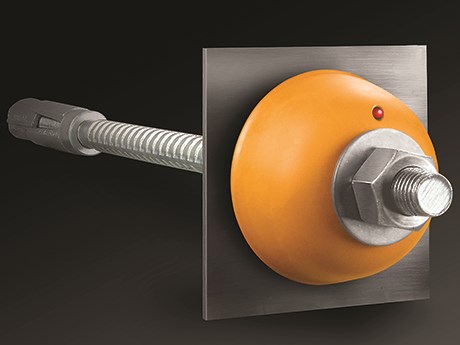Canadian engineer adds another patent to his list
BY NADINE ROBINSON
Fourteen patents and three countries later, Swedish engineer, inventor, and entrepreneur Chris Gotmalm is poised to revolutionize yet another industry. He invented and patented hydraulic transmissions for boats, auxiliary power units for idling reduction in highway trucks, and innovated boat and truck heaters, but has now turned his attention to improving safety and efficiency in mining. Gotmalm and his colleagues at Alert Technologies have developed the ALERT rock bolt monitor (ARBM).
“Our rock bolt monitors tell you when a rock bolt is installed properly, and also warns you the second that it is not working optimally,” said Gotmalm, president of Alert Technologies. “I realized that this project was worth coming out of retirement for, as it can have a profound impact on safety in mines and tunnels.”
Rock bolts stabilize ground walls and roofs in mines and tunnels, preventing rock falls and tunnel collapses. If rock bolts are improperly installed, get damaged through changes in environmental conditions or nearby blasting, they can lose their load bearing capacity, which can lead to collapses, economic losses, injuries and deaths.
“Real-time monitoring of rock bolts will help mitigate disasters in mines and tunnels,” said Hugh MacDonald of Alert Technologies. “Alerts from our ARBMs signal areas that should be evacuated and require reinforcement. Like a seatbelt or smoke alarm, both of which started off as safety perks, we can see our rock bolt technology becoming mandatory in all mines.”
“The current methods of testing rock bolts is quite archaic,” said Gotmalm. “They use a cherry picker and hammer to hit and see if they sound hollow, or they do a pull test on every 100th bolt. Others have used sensors for research purposes, but these are very expensive, and leave a lot of hanging wires. There is another wireless product on the market, but it doesn’t provide continuous monitoring and battery life is between four months and four years. We’ve come up with a low cost, wireless solution that monitors continuously, has an estimated battery life of 23 years (warrantied for 20 years), and alerts users to all of the conditions that lead to rock bolt failure.”
Losing preload, impending overload conditions, and seismic movement can all be identified with the ARBM.
“It can detect that a bolt is never loaded in the first place, as well,” said MacDonald. “Our bolts know when they are installed properly, and will alert the installer to back off the nut if they have overtightened, or signal them to continue tightening to make sure they have the right preload.”
It was a colleague, Josef Mankowski, who came to Gotmalm with the rock bolt idea, following their success on a number of projects since 1982. Mankowski had been on a job in Poland when coal mining engineers there suggested that someone should create an affordable system to report on the failure of rock bolts.
With that, in November 2015, Alert Technologies was officially established. Since then, the rock bolt monitors were tested in London, Ontario, and the patent application was filed. ABRM was launched at MINExpo 2016 in Las Vegas. Gotmalm is now looking to finalize a joint venture for distribution.
The impervious donut shaped device is designed to IP68 standards, meaning it is dustproof and waterproof/submergible.
The ARBM is compatible with a variety of rock bolts. Two standard sizes cover bolts from 16mm to 67mm. Custom sizes up to 100 mm are also possible.
The alert system includes rock bolt monitors, nodes and the CPU. Nodes talk to each other and to the rock bolts and relay messages to the CPU in the office, notifying operators if bolt conditions have changed or if there has been seismic activity.
“With thousands of bolts in mines or tunnels, a maintenance program is required to check the integrity of bolts,” said Gotmalm. “Through visual inspection, you can’t tell if there is a problem. With Alert, they would know instantly which ones to test or replace, focusing maintenance programs, saving time and money.”
The product can be installed new or on retrofit basis as part of a maintenance program without any additional machining or modifications.
“If you want rock bolts installed right the first time, you want ARBM, said MacDonald. “If you want a safe mine, you want ARBM. If you don’t want to spend a lot of maintenance money on perfectly good rock bolts, you want ALERT Rock Bolt Monitors.”



